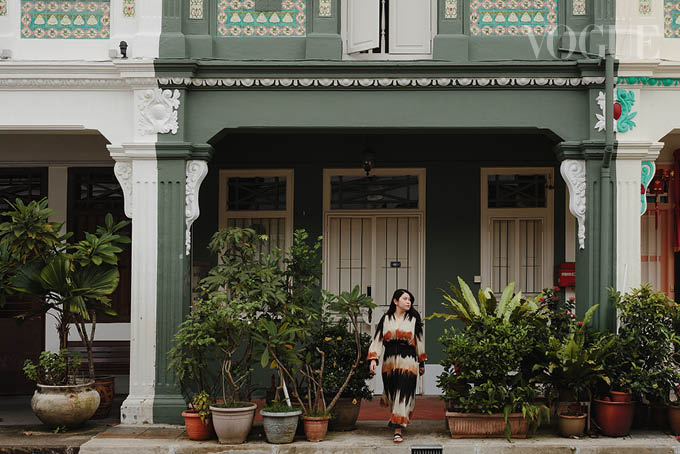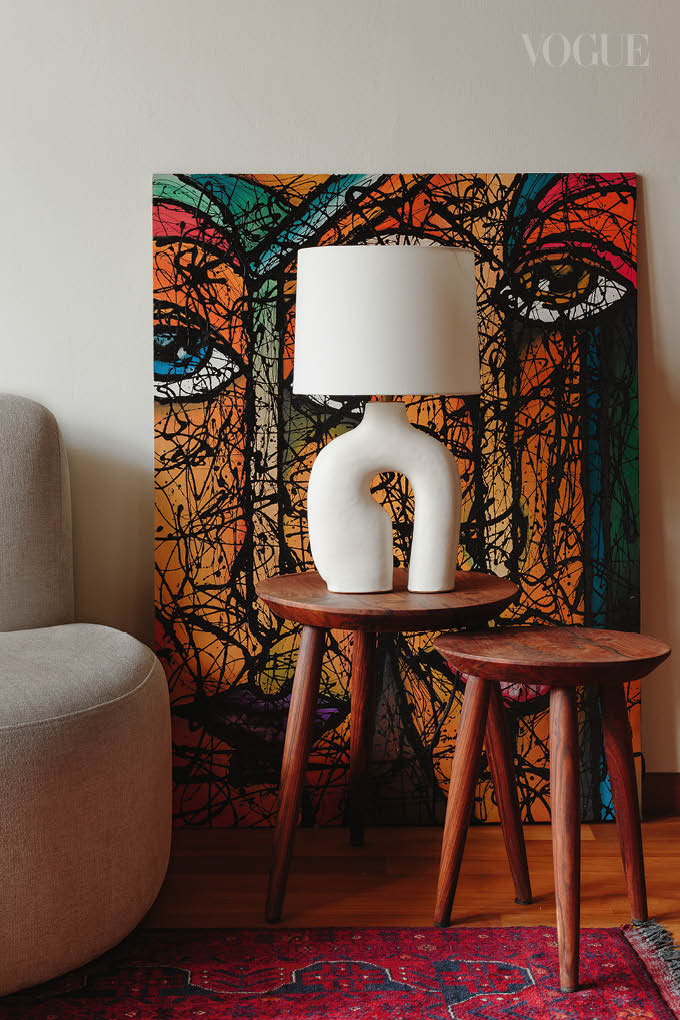Four years after their wedding, events manager Jesslyn Ho accompanied her husband to India, where he had been posted for his work. The couple furnished their home with pieces of furniture acquired there, such as a vintage-looking Indian rosewood mirror embellished with elephants and Winsor armchairs with classic forms. When they returned to Singapore, they brought these pieces back for their new home in a shophouse. Her parents had acquired the historic building to live out their retired years, living on the ground storey and renting the units above. When they invited Ho and her husband to move into the upper storey, she readily agreed, enamoured by the idea of having privacy with a separate entrance yet still being close to family, whom she had missed while away.
This convenience was timely as the couple had recently welcomed a baby girl, Riley, and her parents could pop in easily to help out. The timelessness and age-worn qualities of the shophouse was appealing in its contrast to Ho’s nomadic life. Her childhood saw her moving homes frequently in Singapore and Sydney where her family lived for a time.
“Having had to live abroad, I’ve had to make do with an idea of home wherever I happen to be and however long. The shophouse, with its history and character, imbues a sense of permanence that I otherwise don’t get to enjoy. If my husband, daughter and I continue to move between countries, it’s nice to know that there’s a home waiting for us in Singapore that will be unchanged,” says Ho.

It is not only the 1920s-built shophouse that charms. The street itself is a rare one in Singapore that can be described as pretty. On this lorong (‘street’ in Malay) in Geylang, the shophouse front presents a riot of colour, detail and pattern. This particular home has white-painted fenestrations and original floral basrelief mouldings against olive walls. Glazed porcelain tiles with botanical carvings in green, turquoise and pink frame the windows. The luxuriant foliage of a cluster of potted plants lining the five-foot way complements the picturesque street scene, whose eclectic range of neighbours include traditional Chinese medicine shops and a flamenco dance studio.
Ho did not move in right away. While the shophouse’s facade was attractive, its interior needed work. “It was an investment property for the previous owner, who segregated it into six units until my parents moved in and knocked down walls on the ground storey to create one large unit. We wanted to do the same,” Ho shares. Prior to Riley’s arrival, the couple had envisioned only the two of them living here. Hence, they only took the front of the first storey. There are still three units—two behind accessed via a rear staircase and one in the attic—that are tenanted. But there was the potential for expansion should they one day decide to expand their home.

Researching architects led them to Goy Zhenru, founder of Goy Architects. Her portfolio leans toward textures and a love for refurbishing old buildings. “We wanted to maintain the shophouse’s heritage. She had done up a few shophouses in the past. That was what made us choose her,” Ho reveals. She also felt Goy’s aesthetics were truer to Southeast Asia. “We wanted a local feel that would stay true to the spirit of the shophouse. Given the possibility that we might move overseas again for career reasons, we wanted a place that would age gracefully, one that we could come back to some years later and pick up where we left off. This meant a more organic design and material choices. With wood and stone, wear and patina can add character rather than being a bad thing. We don’t need to worry about anything losing its lustre or any trends going out of fashion,” elaborates Ho.
Walls were demolished to connect two studio apartments into one continuous space to bring light deep into the home. Goy shifted the living room to the front for the owners to enjoy the view of the vibrant vantage of the shophouses opposite. Removing the gypsum ceiling revealed existing timber-supporting battens that Goy decided to expose, resulting in a high volume that gives the living area an airy feel. Modern aluminium frames at the internal courtyard were also changed into full-height timber louvres.

One enters the home into an open kitchen area, which has a bar counter facing the dining room so that the owners can interact with guests while preparing food. This is literally the heart of the home, being sandwiched between the living area and the sole bedroom at the rear. Ho had become quite the cook while abroad. “In India, I started making things I would just go out and buy here. We’d have potluck parties and I’d make satay or ang ku kueh. When you don’t have it there, you crave it,” she laughs.
Goy’s penchant for the handmade is showcased in the customised backsplash tiles from Chiang Mai, Thailand. “We worked with Pakawat ‘Aan’ Boonsong from Saraphi Ceramics Arts and Design to customise a unique green matt glaze. Every hand-pressed tile is unique. The irregular variations add a human touch in a way that I feel pays homage to the handcrafted elements of the shophouse’s facade details,” explains Goy. Kitchen cabinetry doors are wrapped in Chinese ash timber veneer, chosen for its more profound crown expressions. They frame patterned glass panels, inspired by traditional shophouse window design.

In the dining area, a triptych of Chinese cooking sauce bottles rendered in pastel takes centre stage above a chunky dark wood table from Moonler, a recommendation from Goy that gives gravitas to the space. “The artwork of giclée print on fine art paper is by Singapore-based South African artist Sue Gray,” Ho shares. “There is a certain nostalgia looking at it because my mother is very traditional so these were the key ingredients of her kitchen. Cooking and eating are big comfort activities for us and the Chinese bottle labels remind us of home.”
Other multi-hued art pieces around the house accentuate corners and create focal points against the interior’s restrained foundations. Leaning against the wall in the living room is a painting by Pakistani artist Farhan Manto, featuring an abstracted human face detailed with strong black lines and saturated tones. “It was our first artwork bought years ago that got us into this habit of buying art in an impulsive and unmediated way. As it happens, we discovered years later that he is the grandson of Urdu writer Saadat Hasan Manto, whose works we read while living in Delhi,” shares Ho on the delight of this serendipitous moment.

On the same wall against a foreground of a small wooden table with a checkers board is an artwork with a modern twist on the Indian deity Ganesha by Thai artist Home-Sawan Umansap. “We are sometimes asked if we are religious because of it. We’re not but I don’t think one needs to be religious to enjoy a giant colour pencil rendering of Ganesha riding a celestial bird in pastel hues!” muses Ho. The couple had noticed the painting after wandering into the cafe of an art gallery in Thailand. It is another example of the personal stories that layer the historical framework of the house, giving meaning to the material shell.
The largest artwork does not hang on walls. It is a mural on a wall of the courtyard that rises up from the ground storey, throwing a pleasant jolt into the tempered interior design. Enlarged depictions of animals entwined with plant imagery are enlivened with abundant sunlight that washes down the skylight. It was drawn by Colombian artist Didier Jaba Mathieu, who works as a concept artist and digital matte painter at Industrial Light & Magic in Singapore. The artist had once rented one of the rooms from Ho’s parents. “He was living here when they were doing renovations and asked to paint a mural. My dad wanted to incorporate elements of the family. So there is a snake as I’m born in the year of a snake, and a rooster as that’s the Chinese zodiac sign of my mother and brother,” shares Ho.

A personal favourite hangs in the bedroom above Riley’s cot—a splash of colourful swirls and lines against a chalkboard canvas, black as night, by Spanish artist Sandra Partera. The couple stumbled upon her exhibition while holidaying in Barcelona. “It reminds me to let the inner child out more often, and try new things without preconceived notions and the judgement that can come from looking at things through adult eyes,” says Ho. Other favourite pieces include twin oriental vases on the living room bookshelf that hold sentimental value. “My grandparents lived with us when I was a child. They are no longer with us and I was too young to have asked them everything I would have wanted to know about them. My grandfather acquired these vases during or following the Japanese Occupation. When I look at them, I have a vague but deep appreciation for what they must have gone through in their lives and the stories that went untold,” Ho contemplates.
Other pottery includes a bulbous, crimson vase by Singaporean potter Chua Soo Khim. “We love the restrained and balanced style of his ceramics. We’re not sure if there are any younger generation potters who find this style exciting enough to focus their craft on, so every time we see his work, we panic buy,” enthuses Ho. There is also an urn of their previous dog Asterix that moved to Delhi with them but passed on and got cremated there. In its place is Kaya, an Indian spitz that they found in a rescue facility and brought back to Singapore.

The shelf that these vases sit on spans a wall in the living room. It is filled with tomes on various topics including cooking, history, art and literature that attest to the couple’s voracious appetite for knowledge. Two doors conceal the television when not in use. Like in the kitchen, the cabinetry door panels employ timber and patterned glass. Together with wooden furniture and a capacious, white curved sofa, the living room has a relaxed feel. “I love lying in the living room just taking in the sun filtering through the window louvres, the wooden ceiling beams and our book collection,” says Ho.
The home is a receptacle of all the things the couple love, collected with care and to be treasured for life. Their ethos carries on to how they want to bring up their daughter.
“We want her to develop her own personality and sense of self, but she’s also going to see us doing a lot of the things that we are passionate about around the house, such as cooking or reading, so she can decide for herself if these are things she’ll enjoy too,” Ho shares passionately. “If we continue to move from country to country, we hope that will imbue a sense of openness and adventure in her. Yet, we also hope our nomadic lifestyle will conversely make her appreciate home and her roots even more, and cherish this storied shophouse.”
Photography Sayher Heffernan
Styling Jasmine Ashvinkumar
Hair and make-up Sha Shamsi using Gucci Beauty and KMS





